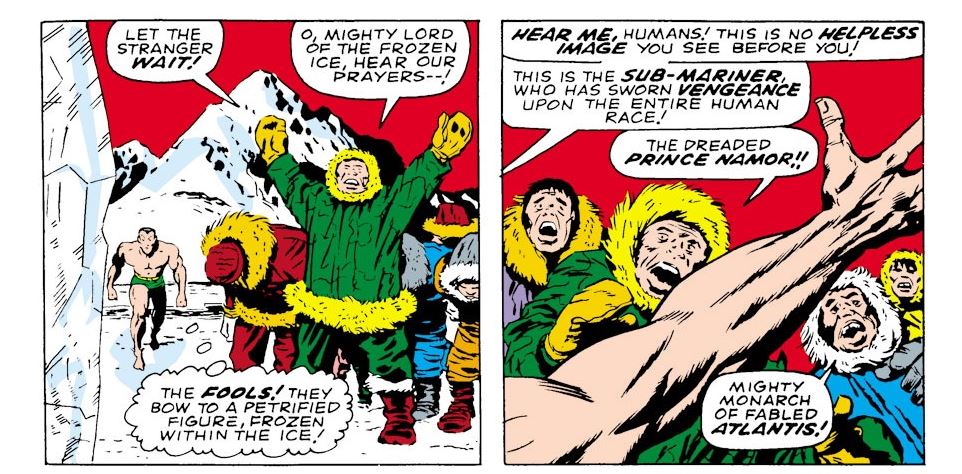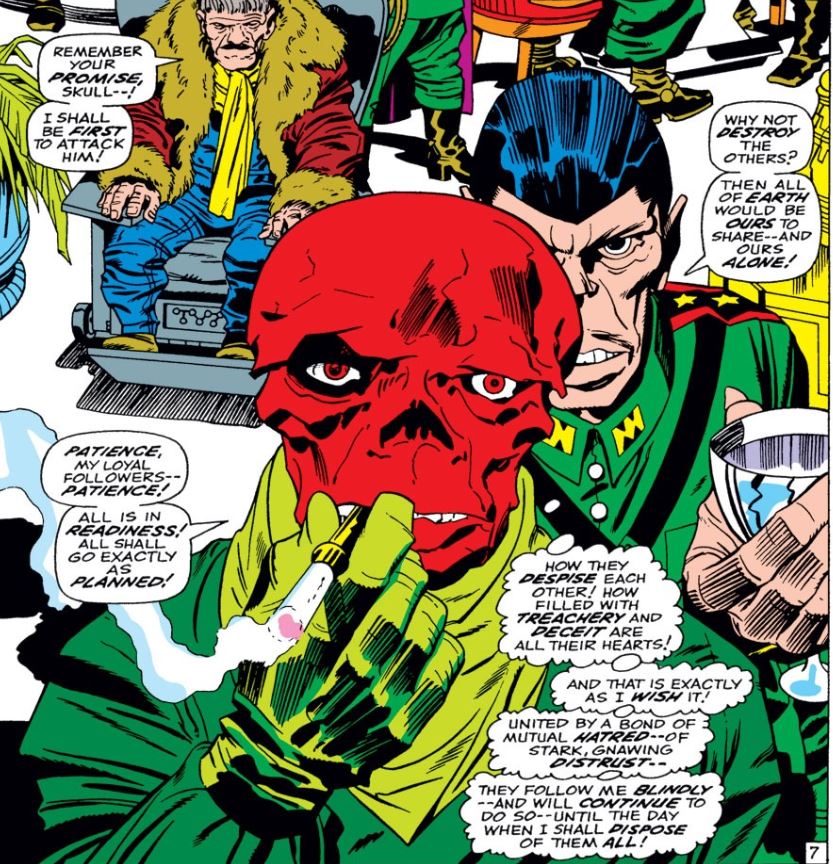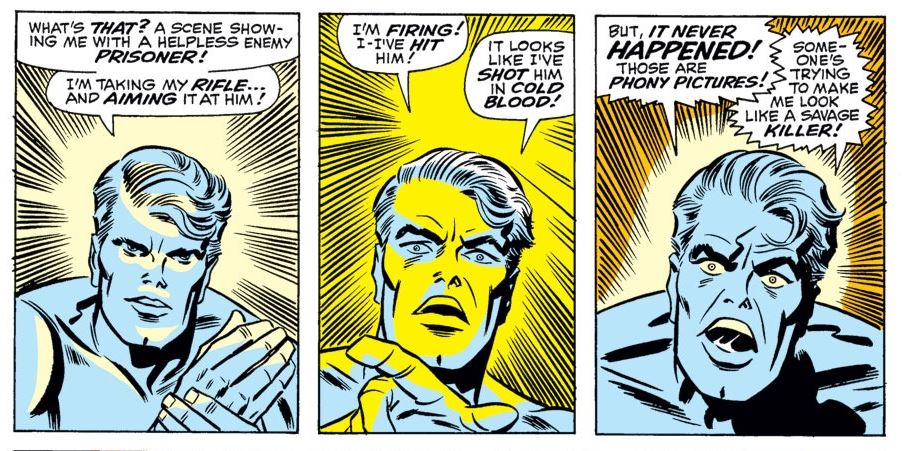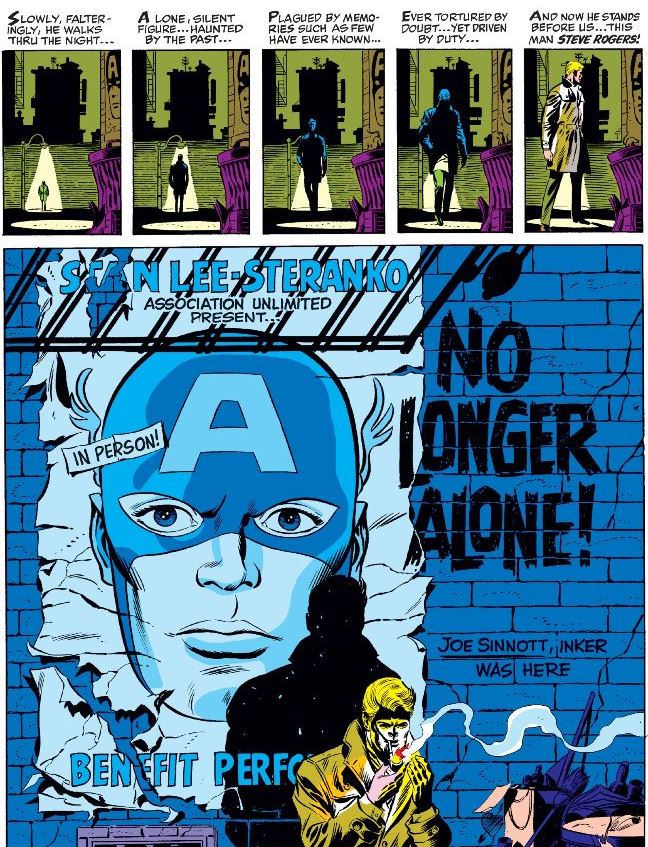Comic Buyer's Guide 1600 Comic Books You Need to Have!
Jul 4, 2022 12:11:53 GMT -5
wildfire2099, thwhtguardian, and 1 more like this
Post by mistermets on Jul 4, 2022 12:11:53 GMT -5
Since I started this around the Fourth of July, it seems appropriate to cover Captain America #100-111 first.

Captain America #100: It seemed a little odd to include this as the first of twelve Captain America issues, as it is the conclusion of a story that kicked of Tales of Suspense (for a while, Marvel published anthology titles with two heroes sharing a monthly title, this may have have been due to a publishing contract with associated of DC Comics so Cap had ten pages a month and Iron Man had another ten in the same book) although Lee and Kirby do make sure to reference the character's backstory in an opening flashback sequence. Then we get a decent story about Captain America realizing the Baron Zemo agent trying to kill him is his SHIELD agent girlfriend on an undercover mission.
An optimistic scene has Black Panther take off his mask to convince Baron Zemo's men to surrender. This is probably not how Nazis will respond to learning that the masked man who defeated man is an African Prince, but it's nice that the Marvel universe is one where that kind of stuff happens.
Grade: A

Captain America #101-104: This is a rather unfocused Red Skull story almost split into three adventures, as a long-lost robot "the fourth sleeper!" awakens, Cap fights an island of exiled Nazis and the Red Skull attaches a nuclear bomb to him. Kirby gets some good stuff to draw, and Red Skull remains one of the nastiest Silver Age Marvel villains, possibly second to Doom, although I have preferred the other Lee/ Kirby Red Skull stories, as well as the follow-up saga with Gene Colan.
Grade: A-
Captain America #105: And after the Red Skull saga, we mainly get a series of single issue stories. While there are still some multi-part Marvel stories at the time, it does appear there's an emphasis on one-off stories, perhaps with the expansion to more monthly titles. This one is kind of intense, as Cap fights three B-listers to save New York from nuclear annihilation. And the story opens with a World War 2 flashback just for the hell of it. I read a review of the final Lee/ Kirby Cap issues that described it as an example of Marvel's grandiose years, and these issues certainly are Silver Age Marvel at its most larger than life.
Grade: B+

Captain America #106: This is a bit of an oddball story as film producers are paid by Communist China to fabricate material in which Cap commits war crimes, as part of an effort to ambush him into a fight with a Life Model Decoy that looks just like Steve Rogers, which will later be used to further frame him. I'm not sure they get much out of that duality, but this issue remains a highlight of Silver Age Marvel just due to Kirby's oddball art when given a conspiracy plot involving movie sets, and the relatively sympathetic motivations of the bad guys, producers trying to make art and seeking money for an operation to save a family member.
Grade: A
Captain America #107: This one-off is a bit derivative of other stories where someone tries to convince a hero he's going insane (Lee/ Ditko Amazing Spider-Man #24 might just be the best version of that story) but Doctor Faustus does go on to be a recurring villain, the details of the conspiracy are dramatic, and all the nightmares lead to some great visuals for Kirby.
Grade: A-
Captain America #108: In this issue, Lee and Kirby seem to remember ongoing storylines revealing where Cap's girlfriend is, and seeding the next encounter with the Red Skull. The bad guy is the Trapster, and it is a bit hard to take seriously. But it is Kirby, so it looks fantastic.
Grade: B+
Captain America #109: This retelling of Cap's origin was chosen as one of fans' favorite Marvel comics ever. I suspect that was somehow a proxy vote for Captain America Comics #1, as somehow no golden age comics made the list, which was biased towards historically significant comics. That said, it is a great comic book, with Kirby at his best, showing off World War 2 Action, and weirdo science experiments. If fans did really vote for it, I credit their good taste.
Grade: A+

Captain America #110-111: Jim Steranko arrives with some of the most innovative comics work ever. Cap has an okay story where he tries to take Rick Jones on as a partner, and struggles to overcome the trauma of losing Bucky, but it's more about the inventive sequences. Madame Hydra immediately becomes a major Marvel villain. There is a plot to have Steve Rogers hide his secret identity which seems unnecessary, but when the visuals are so imprressive, I don't mind too much.
Grade: A+
Most of these stories are reprinted in Marvel Masterworks Captain America Volume 3 (It doesn't include #100, but does include #112's Jack Kirby recap fill-in issue and 113's conclusion to Steranko's Madame Hydra saga.) An extra in the Marvel Masterworks reprint is Steranko's commentary where he goes into detail about his innovative techniques (the man is not humble, but it's interesting.) The grade for that, in the context of it having a $17 cover price on Comixology, is A.
Issues So Far: 12/1600

Captain America #100: It seemed a little odd to include this as the first of twelve Captain America issues, as it is the conclusion of a story that kicked of Tales of Suspense (for a while, Marvel published anthology titles with two heroes sharing a monthly title, this may have have been due to a publishing contract with associated of DC Comics so Cap had ten pages a month and Iron Man had another ten in the same book) although Lee and Kirby do make sure to reference the character's backstory in an opening flashback sequence. Then we get a decent story about Captain America realizing the Baron Zemo agent trying to kill him is his SHIELD agent girlfriend on an undercover mission.
An optimistic scene has Black Panther take off his mask to convince Baron Zemo's men to surrender. This is probably not how Nazis will respond to learning that the masked man who defeated man is an African Prince, but it's nice that the Marvel universe is one where that kind of stuff happens.
Grade: A

Captain America #101-104: This is a rather unfocused Red Skull story almost split into three adventures, as a long-lost robot "the fourth sleeper!" awakens, Cap fights an island of exiled Nazis and the Red Skull attaches a nuclear bomb to him. Kirby gets some good stuff to draw, and Red Skull remains one of the nastiest Silver Age Marvel villains, possibly second to Doom, although I have preferred the other Lee/ Kirby Red Skull stories, as well as the follow-up saga with Gene Colan.
Grade: A-
Captain America #105: And after the Red Skull saga, we mainly get a series of single issue stories. While there are still some multi-part Marvel stories at the time, it does appear there's an emphasis on one-off stories, perhaps with the expansion to more monthly titles. This one is kind of intense, as Cap fights three B-listers to save New York from nuclear annihilation. And the story opens with a World War 2 flashback just for the hell of it. I read a review of the final Lee/ Kirby Cap issues that described it as an example of Marvel's grandiose years, and these issues certainly are Silver Age Marvel at its most larger than life.
Grade: B+

Captain America #106: This is a bit of an oddball story as film producers are paid by Communist China to fabricate material in which Cap commits war crimes, as part of an effort to ambush him into a fight with a Life Model Decoy that looks just like Steve Rogers, which will later be used to further frame him. I'm not sure they get much out of that duality, but this issue remains a highlight of Silver Age Marvel just due to Kirby's oddball art when given a conspiracy plot involving movie sets, and the relatively sympathetic motivations of the bad guys, producers trying to make art and seeking money for an operation to save a family member.
Grade: A
Captain America #107: This one-off is a bit derivative of other stories where someone tries to convince a hero he's going insane (Lee/ Ditko Amazing Spider-Man #24 might just be the best version of that story) but Doctor Faustus does go on to be a recurring villain, the details of the conspiracy are dramatic, and all the nightmares lead to some great visuals for Kirby.
Grade: A-
Captain America #108: In this issue, Lee and Kirby seem to remember ongoing storylines revealing where Cap's girlfriend is, and seeding the next encounter with the Red Skull. The bad guy is the Trapster, and it is a bit hard to take seriously. But it is Kirby, so it looks fantastic.
Grade: B+
Captain America #109: This retelling of Cap's origin was chosen as one of fans' favorite Marvel comics ever. I suspect that was somehow a proxy vote for Captain America Comics #1, as somehow no golden age comics made the list, which was biased towards historically significant comics. That said, it is a great comic book, with Kirby at his best, showing off World War 2 Action, and weirdo science experiments. If fans did really vote for it, I credit their good taste.
Grade: A+

Captain America #110-111: Jim Steranko arrives with some of the most innovative comics work ever. Cap has an okay story where he tries to take Rick Jones on as a partner, and struggles to overcome the trauma of losing Bucky, but it's more about the inventive sequences. Madame Hydra immediately becomes a major Marvel villain. There is a plot to have Steve Rogers hide his secret identity which seems unnecessary, but when the visuals are so imprressive, I don't mind too much.
Grade: A+
Most of these stories are reprinted in Marvel Masterworks Captain America Volume 3 (It doesn't include #100, but does include #112's Jack Kirby recap fill-in issue and 113's conclusion to Steranko's Madame Hydra saga.) An extra in the Marvel Masterworks reprint is Steranko's commentary where he goes into detail about his innovative techniques (the man is not humble, but it's interesting.) The grade for that, in the context of it having a $17 cover price on Comixology, is A.
Issues So Far: 12/1600





